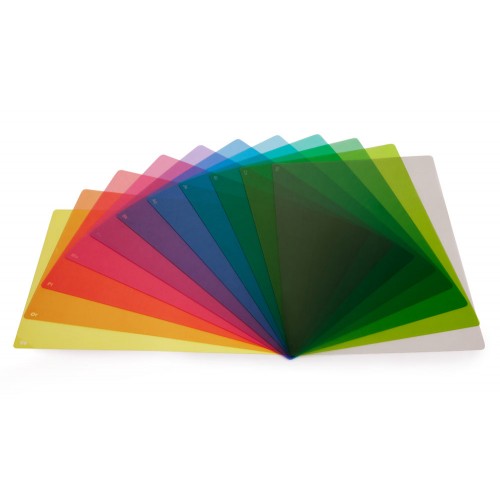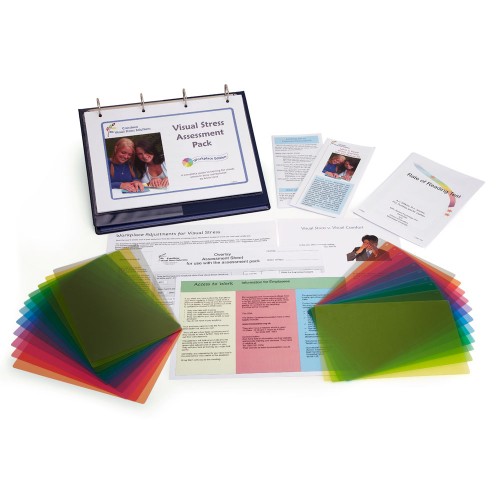Visual Stress and coloured overlays
A quick summary of Visual Stress (sometimes called Irlen Syndrome, Meares-Irlen Syndrome, Scotopic Sensitivity, Visual Stress or Visual Dyslexia)- About 30% of the population are uncomfortable with black text on white backgrounds because their visual cortex is oversensitive to certain wavelengths.
- If you filter out the problem wavelength with someone who has this sensitivity the text becomes clearer, and headaches and migraines can be reduced.
- Visual Stress can exist on its own or alongside other dyslexia-related difficulties and other SpLDs. This set of difficulties is sometimes called "visual dyslexia," but it is not actually dyslexia.
- To see if reading through colour works for you, just get a mixed pack of ten reading rulers or page overlays and try them out.
- For schools, the visual stress assessment pack can quickly screen struggling readers to discover if an overlay or reading ruler could help.
If you want detailsMany children with specific learning difficulties such as dyslexia and autistic spectrum disorders have obvious difficulties with reading and writing that impair their performance in the classroom. These disabilities are often, and correctly, attributed to the processing problems that have been identified as part of their condition. However there are many cases when a child who has been identified as, say, dyslexic, experiences reading problems that are not in fact a consequence of those "dyslexic" difficulties that are usually identified with reference to a phonological processing deficit, but which result from an entirely separate (although often co-occurring) condition which, because it exists alongside the dyslexia, dyspraxia, ADD/HD or autism, can either be masked by it and therefore not addressed as a separate issue, or confused with it with the result that other aspects of the disability may be neglected. This condition is a visual-perceptual disorder variously called Meares-Irlen Syndrome, Scotopic Sensitivity, visual stress or simply Visual Dyslexia. In many cases it can be remedied by a very simple and inexpensive intervention: reading through a coloured overlay that changes the colour of the page. A Coloured Overlay made all the difference"It was the most important moment of my life. For the first time in my life I could see text clear as glass. I was astounded…. All I could think to say was 'How did they do that?'" The above quotation (from "Reading Through Colour", by Professor Arnold Wilkins, Wiley 2003) of the transformation of one teenage boy's experience through the simple procedure of changing the background colour of the text he was attempting to read is in itself startling; but perhaps more significant still is the fact that this is not an exceptionally unusual experience. According to Wilkins, up to 20% of the population of the UK schools where he conducted his research suffered in varying degrees from visual distortions or discomfort associated with reading. The background to Professor Wilkins's research, and the conclusions he draws, are described in detail in his book "Reading through Colour". Results, arrived at using a double-blind protocol, were consistent and measurable, and prove objectively that reading through a correctly selected coloured overlay can significantly improve reading speed and comprehension over an extended time period. One sufferer remembers how, as a child, she used to try and physically pin down the words with her hand as they kept appearing to jump off the page. What is consistent across the spectrum of people, especially children, who experience undiagnosed Visual Stress is that THEY ASSUME THAT THIS IS THE NORMAL READING EXPERIENCE. " Reading is just not for me", they say, and gradually fall behind their peers in an environment that says " Reading is a must for everyone". Written work is also affected as they have difficulty reading their own writing and are therefore inhibited in the processes of correct letter formation. And of course once the work is written down, often mis-spelt and written untidily, the Visual Stress child is unwilling and often unable to access it and it is useless for learning. Frustration, loss of motivation, poor concentration and consequent disruptive behaviour all too often become the norm.
Reducing SymptomsUnlike Dyslexia, which is a distinct neurobiological difference and for which there is no "quick fix", the effects of visual dyslexia can often be easily and inexpensively remedied by the use of coloured overlays or lenses. However, although colour can often be the key, not any colour will do. For each individual there is a specific hue (tint) and saturation (depth of colour) that will "work" best, so it is important that a sufficiently wide selection of colours is provided so that everybody's needs are met. In some cases individuals requiring a deeper saturation "double up" two overlays of the same colour to achieve the desired effect. Recent research by Professor Wilkins showed that an insufficient choice of colours reduces the effectiveness of the intervention as measured by increased reading speed in a significant number of cases. In response to this research, the number of tints in the Crossbow range was increased from five to ten. The correct colour is arrived at by a simple process of elimination, whereby each colour is compared in turn with a white page. If it is not apparent that a particular colour makes the text clearer all the combined hues should be tried, as well as the deeper saturation arrived at by doubling up two overlays of the same colour.
|
|
Although research and classroom experience has proved conclusively that the use of a coloured overlay of the correct colour can do much to increase the reading speed, comprehension and comfort of many children, a significant problem still remains: a sheet of coloured acetate (or similar material) covering the page is a fairly obvious and intrusive intervention that make it clear to the rest of the class that the child in question is experiencing difficulties. The older the student, the less welcome this is going to be.
With this in mind, Crossbow Education developed and patented a more user-friendly application of the coloured overlay principal called the Eye Level Reading Ruler. The Eye Level Reading Ruler is a 2.5" deep plastic strip with tinted transparent edges and an opaque central area that allows the reader to read through the colour of their choice while tracking the line with the edge of the central opaque strip. (see photo). Because the Reading Ruler can slip into a pocket or pencil case, or even remain inside the book as a bookmark, it does not carry the "Special Needs" stigma of a full size coloured overlay. In many schools teachers keep a selection of reading rulers on their desk or in a common resource area, and children - not always those with reading difficulties, either- just help themselves to "their" colour at will. About half the schools in England now use Eye Level Reading Rulers as part of their intervention strategy for students with reading difficulties.
Coloured Overlays or Tinted Lenses?
In some cases, the use of tinted lenses may be preferable to intervention with coloured overlays. For example, overlays may reduce or eliminate the effects of glare on a printed page in a classroom, but the writing on the whiteboard at the front or the posters on the wall may still be causing significant problems. In some cases it may be appropriate for coloured lenses to be prescribed, although as children get older they often become increasingly self-conscious about their lenses and may "forget" to wear them.
Testing for Coloured Lenses
It is often the case that one person will benefit from overlays of one colour, and lenses of another colour. If lenses are to be worn, it is important that a separate professional assessment is carried out. There are two widespread approaches to testing for coloured lenses. One is carried out by a specialist optometrist using the "Intuitive colorimeter", a piece of equipment designed by Professor Arnold Wilkins in conjunction with the Medical Research Council and marketed by Cerium Visual Technologies, which will identify precisely the chromaticity of the illumination of a piece of text most effective in increasing reading speed, giving a measurement that is then used in prescribing tinted lenses. A list of recommended optometrists who test for coloured lenses with the Intuitive Colorimeter can be found here
A different approach is used by the Irlen Institute, working through a selection of lenses combining different coloured layers to arrive at an optimum tint. The system was developed by Helen Irlen under a U.S. federal research grant from 1980-1985. Both systems have their supporters and detractors. There is no doubt that coloured lenses, either from the Irlen or Wilkins systems, are of great benefit to a significant number of people. However it is also true to say, as has already been mentioned, that many children do not benefit from their lenses as much as they might as they can resist wearing them, particularly as they get older. An Optometrist's assessment is only free under the NHS in Scotland.
To conclude, the following observations can be made:
- Visual dyslexia is a reality for about 30% of the population. It can cause headaches, migraines, reading discomfort and distortion of text that can vary from mild to so severe that reading is seriously impaired or even prevented.
- Visual dyslexia needs to be objectively observed. Most sufferers are not aware that their experience of reading differs from that of other people. Fortunately, behaviour associated with visual stress can be quite easy to spot.
- While coloured lenses, prescribed following professional assessment using either of the methods mentioned above, can be more suitable for some people, it remains true that a significant proportion of the population would benefit from the use of a correctly selected coloured overlay.



